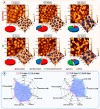Red Blood Cell Storage with Xenon: Safe or Disruption?
- PMID: 38474375
- PMCID: PMC10930635
- DOI: 10.3390/cells13050411
Red Blood Cell Storage with Xenon: Safe or Disruption?
Abstract
Xenon, an inert gas commonly used in medicine, has been considered as a potential option for prolonged preservation of donor packed red blood cells (pRBCs) under hypoxic conditions. This study aimed to investigate how xenon affects erythrocyte parameters under prolonged storage. In vitro model experiments were performed using two methods to create hypoxic conditions. In the first method, xenon was introduced into bags of pRBCs which were then stored for 42 days, while in the second method, xenon was added to samples in glass tubes. The results of our experiment showed that the presence of xenon resulted in notable alterations in erythrocyte morphology, similar to those observed under standard storage conditions. For pRBC bags, hemolysis during storage with xenon exceeded the acceptable limit by a factor of six, whereas the closed-glass-tube experiment showed minimal hemolysis in samples exposed to xenon. Notably, the production of deoxyhemoglobin was specific to xenon exposure in both cell suspension and hemolysate. However, this study did not provide evidence for the purported protective properties of xenon.
Keywords: AFM; blood storage; deoxyhemoglobin; in vitro study; membrane; red blood cells; spectrophotometry; xenon.
Conflict of interest statement
The authors declare no conflicts of interest.
Figures







Similar articles
-
The effect of position and frequency of mixing on canine packed red blood cell units during storage.J Vet Emerg Crit Care (San Antonio). 2022 Mar;32(2):181-188. doi: 10.1111/vec.13164. Epub 2021 Dec 28. J Vet Emerg Crit Care (San Antonio). 2022. PMID: 34962340
-
In vitro hemolysis of stored units of canine packed red blood cells.J Vet Emerg Crit Care (San Antonio). 2018 Nov;28(6):512-517. doi: 10.1111/vec.12770. Epub 2018 Oct 9. J Vet Emerg Crit Care (San Antonio). 2018. PMID: 30299571
-
Hypothermic Preservation of Red Blood Cells in Different Conditions of Inert Gas Xenon: Hyperbaria and Clathrates.Cryo Letters. 2018 Nov/Dec;39(6):391-400. Cryo Letters. 2018. PMID: 30963157
-
Hitchhiker's guide to the red cell storage galaxy: Omics technologies and the quality issue.Transfus Apher Sci. 2017 Apr;56(2):248-253. doi: 10.1016/j.transci.2017.03.006. Epub 2017 Mar 9. Transfus Apher Sci. 2017. PMID: 28343934 Review.
-
Red blood cell hemolysis during processing.Transfus Med Rev. 2002 Jan;16(1):46-60. doi: 10.1053/tmrv.2002.29404. Transfus Med Rev. 2002. PMID: 11788929 Review.
Cited by
-
Developments in the Study of Inert Gas Biological Effects and the Underlying Molecular Mechanisms.Int J Mol Sci. 2025 Aug 5;26(15):7551. doi: 10.3390/ijms26157551. Int J Mol Sci. 2025. PMID: 40806678 Free PMC article. Review.
References
-
- Moroz V.V., Sherstyukova E.A., Kozlova E.K., Sergunova V.A. Storage Time of Filtered Red Blood Cells and Post-Transfusion Complications (Review) Gen. Reanimatol. 2021;17:69–82. doi: 10.15360/1813-9779-2021-1-69-82. - DOI
MeSH terms
Substances
LinkOut - more resources
Full Text Sources
Miscellaneous

